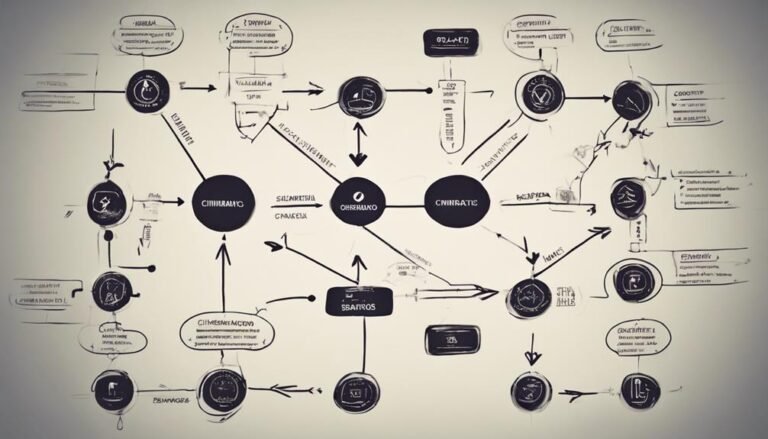Sales Process Automation for Growth
In the fast-paced world of sales, efficiency and optimization are key to achieving sustainable growth. Sales process automation offers a strategic solution to streamline operations, enhance productivity, and drive revenue.
By leveraging technology to automate repetitive tasks and data entry, businesses can focus on what truly matters: building relationships and closing deals. The benefits of sales automation extend beyond just time-saving; it provides valuable insights, accelerates sales cycles, and ensures timely follow-ups.
But how exactly does this automation revolutionize the sales landscape and propel businesses towards success?
Key Takeaways
- Automation streamlines sales processes for efficiency and scalability.
- Real-time tracking provides valuable insights for decision-making.
- Automated workflows ensure timely engagement and optimize conversions.
- Integration of tools enhances productivity, customer satisfaction, and growth potential.
Importance of Automation
In today's rapidly evolving business landscape, the importance of automation in the sales process cannot be overstated, as it plays a pivotal role in enhancing efficiency, scalability, and overall growth potential.
By leveraging automation tools, organizations can streamline repetitive tasks, reduce manual work, and allocate more time to strategic activities. This shift not only increases ROI by driving productivity but also empowers sales teams to focus on building relationships and closing deals rather than getting bogged down in administrative duties.
Automation enables real-time tracking and analysis of sales data, providing valuable insights that can inform decision-making processes. By implementing automated workflows for lead nurturing, follow-ups, and customer communication, businesses can ensure that no opportunity is missed and that prospects are engaged effectively throughout the sales cycle.
This targeted approach not only boosts conversion rates but also enhances customer satisfaction and retention, contributing to long-term revenue growth. In essence, automation is the cornerstone of modern sales strategies, offering a competitive edge by optimizing processes and driving results.
Streamlining Sales Processes
Efficiency optimization through the streamlining of sales processes is essential for maximizing productivity and achieving sustainable growth within organizations. Process optimization involves identifying and eliminating bottlenecks, redundancies, and inefficiencies in the sales cycle.
By analyzing each step of the sales process, businesses can identify areas for improvement, such as reducing manual tasks, automating repetitive processes, and standardizing workflows. Workflow automation plays a crucial role in streamlining sales processes by enabling seamless integration between different tools and systems, reducing errors, and accelerating the sales cycle.
Implementing a CRM system can centralize customer data, automate lead scoring, and provide valuable insights for sales teams to prioritize their efforts effectively. Additionally, integrating sales and marketing automation tools can enable better alignment between the two departments, ensuring a cohesive and efficient approach to lead generation and nurturing.
Enhancing Efficiency and Productivity
Enhancing operational workflows and driving productivity through strategic automation solutions is pivotal for fostering sustainable growth within sales organizations. Efficiency optimization plays a crucial role in ensuring that resources are utilized effectively, reducing wastage of time and effort.
By automating routine tasks such as data entry, lead scoring, and follow-up reminders, sales teams can focus their energy on high-value activities like building relationships and closing deals. This not only streamlines processes but also enhances overall productivity within the organization.
Productivity enhancement is achieved through the elimination of manual and time-consuming tasks, allowing sales representatives to allocate their time more efficiently. Automation tools can provide valuable insights into customer behavior, enabling sales teams to tailor their approach and increase conversion rates.
Additionally, automated reporting features help in tracking key performance indicators, identifying areas for improvement, and making data-driven decisions. By leveraging technology to enhance efficiency and productivity, sales organizations can stay competitive in today's fast-paced business environment.
Improving Lead Management
Effective lead management is crucial for driving sales growth.
Utilizing lead scoring strategies helps prioritize high-potential leads, ensuring sales efforts are focused on the most promising opportunities.
Automated follow-up sequences streamline the nurturing process, increasing the likelihood of converting leads into customers.
Lead Scoring Strategies
Implementing robust lead scoring strategies is essential for optimizing lead management processes and driving overall sales growth. By utilizing scoring criteria and predictive analytics, businesses can efficiently identify high-potential leads and prioritize them for targeted engagement.
Here are key strategies to enhance lead scoring effectiveness:
- Define Scoring Criteria: Establish clear parameters for lead evaluation based on demographics, behavior, and engagement levels.
- Utilize Predictive Analytics: Leverage data insights to forecast lead behavior and likelihood of conversion.
- Continuous Refinement: Regularly review and update scoring models to align with changing market dynamics and customer preferences.
- Sales and Marketing Alignment: Foster collaboration between sales and marketing teams to ensure seamless integration of lead scoring into the overall sales process.
Automated Follow-Up Sequences
Utilizing automated follow-up sequences is a pivotal component in refining lead management processes to nurture prospects effectively and drive conversion rates. When evaluating follow-up effectiveness, automated engagement plays a crucial role in maintaining communication with leads at various stages of the sales cycle. These automated sequences allow for timely responses to inquiries, personalized interactions based on prospect behavior, and consistent engagement to keep the brand top-of-mind. By leveraging automation tools to schedule and track follow-ups, businesses can ensure that no lead falls through the cracks, increasing the likelihood of conversion. The table below illustrates the benefits of incorporating automated follow-up sequences into lead management strategies:
| Benefits of Automated Follow-Up Sequences |
|---|
| Timely Responses |
| Personalized Interactions |
| Consistent Engagement |
| Improved Lead Nurturing |
| Higher Conversion Rates |
Leveraging Data for Insights
In maximizing sales effectiveness, harnessing the power of data to drive decision-making is paramount.
By leveraging insightful analytics, businesses can gain a comprehensive understanding of their customers' behaviors, preferences, and needs.
This strategic approach enables organizations to tailor their sales processes for optimal growth and success.
Data-Driven Decision-Making
To effectively drive strategic decisions and optimize business performance, organizations must harness the power of data-driven insights. Leveraging data analysis and decision-making strategies is crucial for staying competitive in today's market.
Here are key points to consider:
- Data Quality: Ensuring data accuracy and reliability is fundamental for making informed decisions.
- Data Visualization Tools: Utilizing tools like dashboards and graphs can help in interpreting complex data sets efficiently.
- Predictive Analytics: Implementing predictive models can forecast future trends and outcomes, aiding in proactive decision-making.
- Continuous Monitoring: Regularly monitoring key performance indicators allows for adjustments based on real-time data, enhancing decision agility and effectiveness.
Insightful Analytics Utilization
Harnessing the power of insightful analytics is essential for organizations seeking to derive actionable insights from their data to drive informed decision-making and strategic growth.
Predictive analytics plays a crucial role in this process by utilizing historical data to forecast future trends and behaviors accurately. By leveraging predictive analytics, businesses can anticipate customer needs, optimize sales strategies, and enhance overall performance.
Additionally, data visualization tools enable organizations to present complex data in a visually appealing format, making it easier for stakeholders to interpret and understand key insights. Through effective data visualization techniques, companies can identify patterns, trends, and outliers within their data, empowering them to make data-driven decisions that propel growth and success.
Enhancing Customer Experience
Emphasizing personalized interactions throughout the sales process can significantly elevate the customer experience. When focusing on enhancing customer experience, the following strategies can be implemented:
- Customer Segmentation: Divide customers into specific groups based on demographics, behaviors, or preferences to tailor interactions accordingly.
- Personalized Communication: Utilize customer data to personalize communication channels such as emails, calls, or messages, creating a more engaging experience.
- Customized Solutions: Offer personalized solutions that cater to the individual needs and challenges of each customer, showcasing a deep understanding of their requirements.
- Feedback Integration: Actively seek feedback from customers at various touchpoints in the sales process to understand their satisfaction levels and areas for improvement, fostering a sense of partnership.
Accelerating Sales Cycles
Building upon the foundation of enhancing customer experience, a crucial aspect in optimizing sales performance is expediting the sales cycles to maximize efficiency and drive revenue growth. Sales cycle optimization plays a pivotal role in streamlining the process from lead generation to closing the deal. By accelerating conversions, businesses can capitalize on opportunities swiftly, reducing the time taken at each stage of the sales funnel.
Customer engagement is key in this process. Personalized interactions, timely responses, and tailored solutions can significantly impact the speed at which prospects move through the sales pipeline. Sales teams must align their strategies with the goal of accelerating sales cycles, ensuring that every touchpoint with the customer adds value and nudges them closer to making a purchase.
Effective sales cycle optimization requires a deep understanding of customer needs and pain points, allowing businesses to tailor their approach for maximum impact. By aligning sales team efforts with this goal, organizations can drive efficiency, boost revenue, and foster long-term customer relationships.
Optimizing Follow-Ups and Nurturing
To enhance sales performance and foster stronger customer relationships, a strategic focus on optimizing follow-ups and nurturing is paramount in driving revenue growth. In today's competitive landscape, businesses must prioritize personalized outreach and targeted messaging to engage effectively with their leads and customers. Here are key strategies to optimize follow-ups and nurturing:
- Personalized Outreach: Tailoring communication to individual customers based on their preferences, behavior, and needs can significantly increase engagement and response rates.
- Targeted Messaging: Crafting messages that resonate with specific customer segments ensures that the communication is relevant and valuable, enhancing the overall customer experience.
- Relationship Building: Focus on building long-term relationships by consistently providing value, addressing customer concerns, and demonstrating genuine interest in their needs.
- Customer Engagement: Encourage two-way communication through various channels to keep customers engaged and informed, fostering loyalty and repeat business opportunities.
Integrating Automation Tools
Integrating automation tools in sales processes holds numerous benefits such as improving efficiency, reducing manual errors, and ensuring consistency in customer interactions.
By streamlining sales processes through automation, companies can save time and allocate resources more effectively, ultimately leading to increased productivity and revenue generation.
Moreover, enhancing communication efficiency with automated tools enables sales teams to engage with leads and clients promptly and consistently, fostering stronger relationships and boosting overall sales performance.
Tool Integration Benefits
Efficient utilization of automation tools in the sales process can lead to significant enhancements in productivity and customer satisfaction. When integrating automation tools, businesses can experience the following benefits:
- Integration Benefits: Seamless integration of various tools allows for a more holistic view of the sales process, enabling better decision-making and more personalized customer interactions.
- Efficiency Gains: Automating repetitive tasks streamlines workflows, freeing up time for sales teams to focus on building relationships and closing deals.
- Tool Compatibility: Ensuring that automation tools are compatible with existing systems reduces downtime and minimizes disruptions in the sales process.
- Seamless Workflows: Integrated tools promote a smooth flow of data and information, reducing errors and improving overall efficiency.
Streamlining Sales Processes
When optimizing sales processes through the strategic integration of automation tools, a meticulous approach to workflow refinement is essential for achieving heightened efficiency and customer-centric outcomes. Process optimization involves analyzing each step of the sales process to identify bottlenecks and areas for improvement.
By implementing workflow automation, businesses can streamline tasks such as lead management, follow-ups, and reporting, reducing manual errors and saving time. Automation tools can also provide valuable insights into customer behavior and preferences, enabling sales teams to personalize interactions and drive conversions.
Integrating these tools not only enhances productivity but also ensures a seamless and consistent experience for customers, ultimately leading to increased sales and business growth.
Enhancing Communication Efficiency
Communication efficiency in sales can be significantly enhanced through the strategic integration of automation tools that streamline processes and optimize interactions with customers. By implementing automation tools, businesses can achieve a higher level of efficiency and effectiveness in their communication strategies.
Here are four key ways automation tools can enhance communication efficiency:
- Automated Email Campaigns: Sending personalized emails at scale to nurture leads and engage with customers.
- CRM Integration: Ensuring seamless communication by integrating automation tools with Customer Relationship Management systems.
- Chatbots for Instant Responses: Providing quick and accurate responses to customer inquiries 24/7.
- Social Media Automation: Scheduling posts, tracking engagements, and analyzing customer interactions across social media platforms.
Integrating these automation tools can revolutionize communication processes and drive sales growth.
Measuring and Analyzing Performance
To ensure continuous improvement and success in sales process automation, it is essential to meticulously measure and analyze performance metrics. Measuring effectiveness involves tracking key performance indicators (KPIs) such as conversion rates, sales cycle length, and customer acquisition costs. By analyzing these metrics, businesses can identify bottlenecks, optimize processes, and enhance overall efficiency.
Performance analysis plays a crucial role in understanding the effectiveness of automation tools and strategies. It helps in evaluating the impact of automation on sales productivity, lead generation, and revenue growth. Through detailed performance analysis, organizations can pinpoint areas that require improvement and make data-driven decisions to drive better results.
Utilizing performance analytics tools and software can streamline the measurement process and provide real-time insights into sales performance. These tools offer dashboards and reports that visualize data trends, allowing sales teams to monitor progress, identify patterns, and forecast future outcomes accurately. By leveraging performance analysis effectively, businesses can fine-tune their automation strategies, optimize sales processes, and achieve sustainable growth.
Conclusion
In conclusion, sales process automation plays a crucial role in driving growth and efficiency within organizations.
By streamlining processes, enhancing productivity, improving lead management, leveraging data insights, accelerating sales cycles, optimizing follow-ups, and integrating automation tools, businesses can achieve higher levels of success.
Just as a well-oiled machine operates seamlessly to achieve its objectives, automation in sales processes allows companies to operate with precision and effectiveness, ultimately leading to increased revenue and success.







